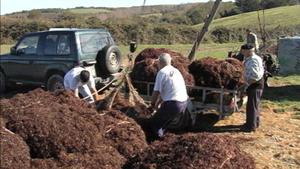The consequences of climate change are manifested in the marine flora of the Basque coast
2012/08/14 Etxebeste Aduriz, Egoitz - Elhuyar Zientzia Iturria: Elhuyar aldizkaria

Since the 1980s, the water temperature in the eastern Cantabrian sea has increased 0.24 °C per decade to 0.33 degrees in summer. That is, in the last 30 years the average water temperature in summer has increased almost 1 °C. This increase, along with other factors derived from climate change, is causing significant changes in marine vegetation. This has been pointed out by the UPV research group Itsas Bentos in the journal Estuarine, Coastal and Shelf Science.
“On Earth a change of these characteristics seems insignificant, since on the same day the temperature can increase or decrease by ten degrees. The temperature changes in the sea are slower. Therefore, the increase of a degree of temperature in the sea in the last three decades is a very significant change and undoubtedly has had consequences in the vegetation,” said José María Gorostiaga, professor of the Department of Plant Biology and Ecology of the Faculty of Science and Technology and director of the group Itsas Bentos.
The study reveals that spring and summer rainfall have decreased considerably in the last 30 years. “The decrease in rainfall in summer and the greater stratification of sea water make the water more transparent and the sun affects more to the bottom of the sea and the food decreases. All of them have negatively influenced the conservation of some species of algae,” explains Isabel Díez, another of the authors of the study.
Data from a pioneering research carried out by Gorostiaga in 1991 were compared with those recorded in the same locations with the same methodology between 2008 and 2009. “We detected, for example, that copated algae, species similar to terrestrial trees that form seagrass along the Basque coast, were suffering a process of deforestation,” said Gorostiaga.
“The lamineros, the algae that live in colder waters, were abundant in San Juan de Gaztelugatxe and Bakio in the early 90s, but they have now completely disappeared. Foreign species have increased,” explains Díez. In the study, it has also been observed that the diversity of simple and small seasonal algae has increased and is greater.
The UPV-EHU Itsas Bentos group has concluded that algae are very sensitive to climate change and can be used as an indicator. “The changes come from the simultaneous interaction of several factors. Therefore, it is very difficult to foresee how these phenomena will be developed. We will know more details thanks to the projects we carry out both in the field and in the laboratory,” added Díez.
Together with Gorostiaga and Díez they participated in the study Nahiara Muguerza, Alberto Santolaria and Unai Ganzillo, belonging to the Department of Plant Biology and Ecology.

Gai honi buruzko eduki gehiago
Elhuyarrek garatutako teknologia




